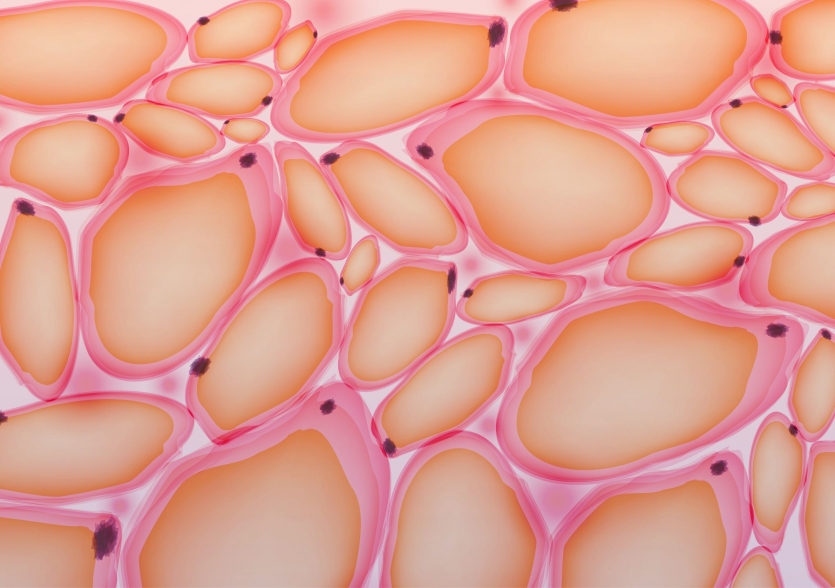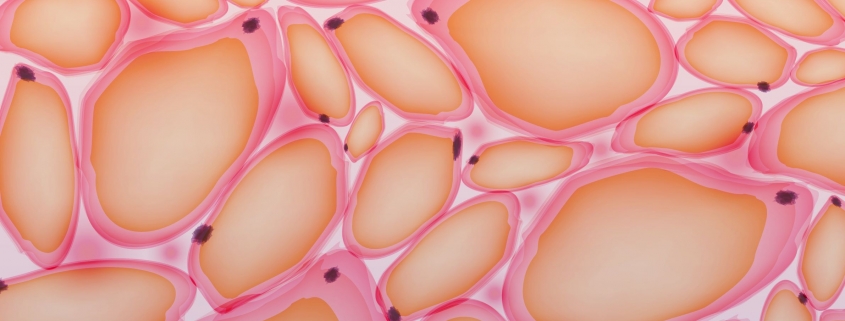Cut the Fat—Just the Facts About Adipose Tissue

It’s common to have an adversarial relationship with fat. You’re taunted by it when you look in the mirror. You curse your body fat. You pinch it and try hard to burn it off. But maybe instead of open hostility, it’s time to try to understand fat tissue—or, by its impressive, scientific name, adipose tissue.
This attitude isn’t the fault of the individual alone. Society at large has a complicated relationship with fat tissue. The conflict stems from a plethora of misunderstandings and misconceptions. The lack of knowledge about fat functions creates a simplified understanding of adipose tissue’s biological importance.
You can expand your understanding of all things adipose with the answers to common questions about fat tissue. Learn about formation, function, and fun facts that will reshape your relationship with body fat.
Q. Besides a constant source of ire, what is fat tissue actually?
A. The definition of fat or adipose tissue is fairly simple. It’s loose connective tissue that acts as energy storage. That’s the very basics of fat tissue.
The more formal name (adipose tissue) comes from the fact that this type of tissue is made up of adipocytes—commonly referred to as fat cells. The moniker fits because their main job is to store excess calories as fatty acids called triglycerides.
These reserves of energy in physical form are stashed throughout the body. You tap into the fatty acids in adipose tissue when energy intake and carbohydrate stores—as glycogen—are depleted. It’s a process that’s familiar to those on keto diets or who practice intermittent fasting.
One other easy misunderstanding about fat needs to be cleared up right away. Eating dietary fat of any type doesn’t transfer directly to adipose tissue. Sure, the fat tissue on your body is similar at a molecular level to the fat you eat. Lipids and fatty acids form the building blocks of all fats—including adipose tissue. But the fat you eat goes through a lot before it possibly is incorporated into adipocytes.
Digestion breaks down the fats you eat into component parts. Some of that energy is burned off. Some is used to build structures or for other health-maintenance purposes throughout the body. The leftover energy from dietary fat can then be stored in adipose tissue. So instead of avoiding fats in your diet, just look for healthy, plant-based sources. And remember the caloric price tag, because fat packs nine calories per gram.
Q. Is there more to adipose tissue than just fat? Or are there other components?
A. Your body fat is more complex than the simplified villain narrative that pervades pop culture. There are the adipocytes, of course, and plenty of small blood vessels to maintain circulation into the adipose tissue. Nerve and endocrine (hormone producers) cells as well as lymphatic pathways are also found in fat tissue.
But the biggest non-fat component of adipose tissue is the stromal vascular fraction (SVF). This important element is a collection of diverse cell types—including mature cells (vascular, smooth muscle, blood and immune cells, as well as fibroblasts) and stem cells. Millions of these SVF cells aren’t fat-filled, but provide structure and material that can adapt as the tissue needs fluctuate.
Q. What health and survival functions do fat tissue perform?
A. Of course, you don’t want too much adipose tissue, but having too little is a problem as well. That’s because fat isn’t just a physical punishment for unhealthy eating or a lack of exercise. It has crucial biological functions that keep you alive and thriving.
The main functions include:
- Energy storage—This main adipose purpose (already discussed above) is a survival mechanism to make the most of bountiful food supplies by stashing some for later.
- Heat—Animals in cold climates use blubber to keep them warm, and this phenomenon exists in humans—especially babies, but research is showing the role fat plays in heating adults, too.
- Padding—Accumulated adipose tissue cushions your organs to provide a measure of protection.
- Metabolic impact: Using secretions (hormones, cytokines, and other metabolites), adipose tissue helps regulate energy balance, appetite, and various metabolic actions.
- Hormone production: As an endocrine organ, fat tissue makes a variety of hormones, like leptin, adiponectin, and resistin.
Q. Fat is an organ?!
A. Yes. You read that right—adipose tissue is considered an endocrine organ. And a big one, too. This designation is based on fat tissue’s ability to produce hormones—literally the definition of an endocrine organ.
Your adipose tissue’s communication and influence on metabolic activities are helped by the array of hormones it makes. Leptin is especially important for energy regulation. It interacts with your brain’s hypothalamus and helps maintain the body weight over time. It’s one of the reasons dieting is so hard.
Q. Are there different types of adipose tissue?
A. Indeed there are different forms of adipose tissue. And they’re conveniently color-coded to keep them separate.
White fat tissue acts as the energy storehouses for the extras from your diet. That’s also what’s pulled from when your body runs out of easily burned sugars. Your white adipose tissue also handles the hormone secretions that come from your body fat.
Brown fat tissue is thermogenic—packed with more blood vessels and to help maintain warmth. Science has known this kind of fat was in newborns. But up until recently, it wasn’t thought to play much of a role in adults.
Adipose tissue is also often described by where it is on the body.
Q. Where does fat accumulate?
A. The midsection is the first place you might look for body fat. But a round belly is only one place you’ll find fat-stuffed adipose tissue.
In fact, fat is all over your body.
Adipose tissue is tucked into the innermost layer of your skin. This subcutaneous fat is what you measure with calipers or pinch to check your weight-management progress. It’s also the fatty tissue that’s easiest to spot.
You can’t exactly see visceral fat—though evidence of it (a pot belly) can become apparent with too much accumulation. This type of fat describes the adipocytes clustered inside your abdominal cavity and around your internal organs. You need some for padding, but too much visceral fat can hamper health.
Fat is also laced between your muscle fibers (intermuscular fat) and inside your bone marrow. That yellow bone marrow—the kind where adipocytes are found—is important for stem cell production.
Q. Can you really not eliminate fat cells? What’s the process to remove adipose tissue and slim down?
A. You were born with tens of billions of fat cells and they aren’t going anywhere. You’ll likely have them, and maybe more, for the entirety of your life. That’s because, while you can’t naturally destroy fat cells, you can add more adipose tissue. And once it’s there, it doesn’t go away, either.
Sorry if that’s bad news. Liposuction can literally suck up and permanently remove adipose tissue located under your skin. But there’s simply no way to diet or exercise away your adipose tissue.
If that’s true—and it certainly is—how do you burn fat naturally to improve your physique?
Fat tissue is made up of adipocytes that act as little energy storage containers of lipids. When your body is in a state where it has to rely on stored fat for energy, the necessary amount of containers are emptied.
The storage structures stay, but they are no longer plumped up by the fat that filled them. This helps you look slimmer. Just remember that those adipocytes can be filled back up in the future—depending on your calorie expenditure and intake.
Q. Is there a correct amount of fat tissue?
A. Like most health indicators, there isn’t a single number that works for everyone. Instead, there is a healthy range for body fat percentage and body mass index (BMI).
Women with 10-31 percent body fat are considered in the healthy range. For men, the numbers are between two and 24 percent. If you’re looking to use BMI, the healthy range is 18.5–24.9.
There are other factors—age and activity level, for instance—that may make your target range slightly different. But the important takeaway about body fat is that you do need some, but too much isn’t good for maintaining optimal health.
Also, dealing with fat loss purely based on your weight isn’t the right approach. When you’re talking about fat tissue amounts, body composition is the keyword. That’s why the measurements you see above aren’t tied to a number to shoot for on the scale.
Use Your Knowledge About Adipose Tissue to Shape Your Health
Now that you understand more about your body fat—including a cool new name, adipose tissue—that doesn’t mean you’ll stop pinching it or trying to burn it off. But come at your relationship with fat from a place of knowledge and understanding.
Utilize your newfound knowledge to smartly design your lifestyle to achieve the right fat-related goals. Respecting the way adipose tissue works, the functions it performs, and its impact on your body can inform your dietary and exercise choices.
Next time you look in the mirror and are ready to curse your stubborn adipose accumulations, remember fat isn’t automatically bad. Fat tissue isn’t a black-and-white issue. Now you know adipose is a matter of brown and white tissue.
References
https://www.yourhormones.info/glands/adipose-tissue/
https://www.britannica.com/science/adipose-tissue
https://www.mentalfloss.com/article/501419/12-enlightening-facts-about-body-fat
https://www.ncbi.nlm.nih.gov/pmc/articles/PMC3775412/
https://www.ncbi.nlm.nih.gov/pmc/articles/PMC4985254/
https://www.livescience.com/62218-whats-in-a-fat-cell.html
https://pubmed.ncbi.nlm.nih.gov/23283583/
https://www.ncbi.nlm.nih.gov/pmc/articles/PMC4091429/










